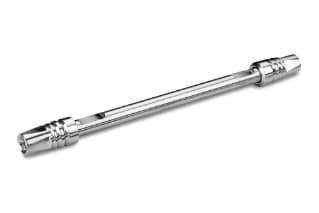
|
Chemistry |
Phenyl |
|
Separation Mode |
Reversed Phase |
|
Particle Substrate |
Silica |
|
pH Range Min |
2 pH |
|
pH Range Max |
8 pH |
|
Temperature Limits |
45 C |
|
Maximum Pressure |
18000 psi (1240 Bar) |
|
Endcapped |
Yes |
|
Bonding Technology |
Phenyl-Hexyl |
|
Silanol Activity |
Low |
|
Particle Shape |
Spherical |
|
Particle Size |
2.7 µm |
|
Endfitting Type |
Parker-style |
|
Pore Size |
90 Å |
|
Format |
Column |
|
Surface Area |
100 |
|
System |
UPLC, UHPLC |
|
Particle Technology |
Solid Core |
|
USP Classification |
L11 |
|
Inner Diameter |
2.1 mm |
|
Length |
100 mm |
|
Carbon Load |
5.9 % |
|
eCord |
Yes |
|
UNSPSC |
41115709 |
|
Brand |
CORTECS |
|
Product Type |
Columns |
|
Units per Package |
1 pk |

CORTECS Phenyl Column, 90Å, 2.7 µm, 2.1 mm X 100 mm, 1/pk
Choose the Waters CORTECS Phenyl Column to achieve high efficiency and lower operating back pressure when compared to fully porous particles of comparable particle size. This enables you to carry out techniques using conventional LC instruments while preserving effectiveness and resolution. Longer columns can be used to enhance resolution for co-eluting peaks in complex sample combinations.
Use the CORTECS Phenyl Column's alternate selectivity to C8 and C18 stationary phases to take advantage of analyte interactions with the benzyl ring. When utilizing methanol as the organic modifier, the variations in selectivity for this phase are especially noticeable for aromatic molecules. Additionally, the lab equipment can deliver exceptionally low column MS bleed, a long lifetime, and excellent peak shape.
The CORTECS Phenyl Column packing materials are manufactured in a cGMP, ISO 9001 accredited facility using ultra-pure reagents and were developed specifically for use with the ACQUITY UPLC System. In order to guarantee exceptional, consistent performance, each batch of the CORTECS Phenyl Column packing material is chromatographically tested with acidic, basic, and neutral analytes. Each column is separately analyzed, and the results are given on the eCordTM Intelligent Chip in the form of a Performance Chromatogram and Certificate of Batch Analysis. The bonded phase batch number and the findings of the analytical tests are both listed on the Certificate of Analysis. On the other hand, the Performance Chromatogram summarizes the performance of each particular column and offers the batch number, column serial number, USP plate count, USP tailing factor, USP retention factor, and the chromatographic test conditions. For the purpose of future reference, Waters advises that these data sets be captured and kept.
You may also want to learn more about the Reversed-Phase QC Reference Material. The Reversed-Phase QC Reference Material is a very complex mixture of reference material because it contains components that can be challenging to separate. It is suitable for use when regularly carrying out difficult tests because it is designed to deliver this level of complexity. It functions with a variety of system lab equipment and column chemistries, sizes, and shapes.
Seven substances, including uracil, butyl paraben, naphthalene, propranolol, dipropylphthalate, acenaphthene, and amitriptyline at pH 7, are included in the reversed-phase quality control reference material. The benchmark performance of your analytical HPLC or UPLC equipment should be verified using this standard mixture.
What Mobile Phase Should Be Used With The CORTECS Phenyl Column?
The mobile phase used with the CORTECS Phenyl Column depends on the type of compounds being separated. In general, a mixture of water and acetonitrile or methanol is used, with the addition of an acid or a salt to adjust the pH or enhance ion pairing. For example, a mobile phase consisting of 90% water and 10% acetonitrile with 0.1% formic acid has been used for the separation of flavonoids.